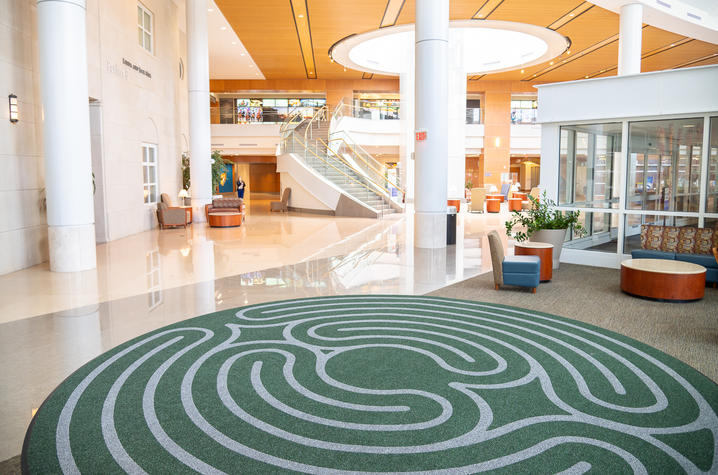Labyrinth Offers Place For Contemplation, Meditation

LEXINGTON, KY. (July 9, 2020) – In a busy hospital, it can be hard to find a place for quiet contemplation; a place where staff, patients and visitors can collect their thoughts, release stress and have a moment of calm.
But just inside the atrium of UK’s Chandler Hospital, inset on the floor, there is what looks like a maze but is in fact a “walking labyrinth” – a winding circular path with a start but no end, that winds around itself in an endless loop.
“Walking labyrinths can be found all over the world, and in other medical campuses, as an opportunity for those who walk its path to seek spiritual centering, contemplation, and prayer,” said social work doctoral student Abbie Latimer, part of the team who spearheaded the effort to have the labyrinth installed. “It is intended for people of all faiths and for those who do not consider themselves religious or spiritual.”
The labyrinth is an ancient symbol dating back to the Neolithic and Bronze Age. Originally found carved into or painted on rocks, the symbol later appeared on coins and in manuscripts. Over time, the labyrinth began to appear in the tile work of buildings and as pathways formed by hedges or stone. Unlike a maze, where the path presents a problem to be solved and the exit must be found, the path of a labyrinth is unicursal (one way in, one way out). It is a symbol of wholeness and a metaphor for the journey to the center of our deepest selves. In times of challenge, it may be used as a tool for reflection and respite. The labyrinth can be used as a form of meditation or spiritual practice to help center and calm one’s self.
“We are very happy to be able to offer this modality to our staff and patients,” said Dr. Connie W. Jennings, medical director of Integrative Medicine and Health at UK HealthCare. “Different forms of meditation speak to us in different ways. For some, contemplation comes through music, maybe exercise, yoga or writing. We each search for ways to recharge, reset our balance. Walking the labyrinth, finding a moment of respite at its center before returning to one’s usual pace of life is meant to provide a quiet, individualized time of healing.”
The labyrinth was funded in part by an award by the Donovan Memorial Trust, which is dedicated to enriching culture and educational opportunities by developing an appreciation of culture and beauty and represents a collaboration between UK's Palliative and Supportive Care Department, Arts in HealthCare, Pastoral Care Services and Integrative Medicine and Health. Arts in HealthCare and Integrative Medicine and Health also contributed to the cost.
“Each of the team members had a dedicated interest into seeing this project be successful as we all understand the importance and power of having a space to be in that gives you time to reflect,” said Latimer. “This is true not only for our patients and families who may be experiencing the worst or best day of their life in our hospital walls- but also for the professionals who have worked so tirelessly with the COVID-19 pandemic and every day before and after.”
The labyrinth is located in Chandler Hospital’s pavilion A, outside the Gill Imaging Center.
As the state’s flagship, land-grant institution, the University of Kentucky exists to advance the Commonwealth. We do that by preparing the next generation of leaders — placing students at the heart of everything we do — and transforming the lives of Kentuckians through education, research and creative work, service and health care. We pride ourselves on being a catalyst for breakthroughs and a force for healing, a place where ingenuity unfolds. It's all made possible by our people — visionaries, disruptors and pioneers — who make up 200 academic programs, a $476.5 million research and development enterprise and a world-class medical center, all on one campus.




